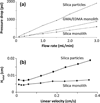Affinity monolith chromatography: a review of principles and recent analytical applications
- PMID: 23187827
- PMCID: PMC3578177
- DOI: 10.1007/s00216-012-6568-4
Affinity monolith chromatography: a review of principles and recent analytical applications
Abstract
Affinity monolith chromatography (AMC) is a type of liquid chromatography that uses a monolithic support and a biologically related binding agent as a stationary phase. AMC is a powerful method for the selective separation, analysis, or study of specific target compounds in a sample. This review discusses the basic principles of AMC and recent developments and applications of this method, with particular emphasis being given to work that has appeared in the last 5 years. Various materials that have been used to prepare columns for AMC are examined, including organic monoliths, silica monoliths, agarose monoliths, and cryogels. These supports have been used in AMC for formats that have ranged from traditional columns to disks, microcolumns, and capillaries. Many binding agents have also been employed in AMC, such as antibodies, enzymes, proteins, lectins, immobilized metal ions, and dyes. Some applications that have been reported with these binding agents in AMC are bioaffinity chromatography, immunoaffinity chromatography or immunoextraction, immobilized-metal-ion affinity chromatography, dye-ligand affinity chromatography, chiral separations, and biointeraction studies. Examples are presented from fields that include analytical chemistry, pharmaceutical analysis, clinical testing, and biotechnology. Current trends and possible directions in AMC are also discussed.
Figures











Similar articles
-
Affinity monolith chromatography: A review of general principles and applications.Electrophoresis. 2017 Nov;38(22-23):2837-2850. doi: 10.1002/elps.201700101. Epub 2017 May 22. Electrophoresis. 2017. PMID: 28474739 Free PMC article. Review.
-
Affinity monolith chromatography: A review of general principles and recent developments.Electrophoresis. 2021 Dec;42(24):2577-2598. doi: 10.1002/elps.202100163. Epub 2021 Aug 12. Electrophoresis. 2021. PMID: 34293192 Free PMC article. Review.
-
Affinity monolith chromatography.J Sep Sci. 2006 Aug;29(12):1686-704. doi: 10.1002/jssc.200600152. J Sep Sci. 2006. PMID: 16970180 Review.
-
Bioaffinity chromatography on monolithic supports.J Sep Sci. 2010 Feb;33(3):422-38. doi: 10.1002/jssc.200900635. J Sep Sci. 2010. PMID: 20099259 Review.
-
Current trends in affinity-based monoliths in microextraction approaches: A review.Anal Chim Acta. 2019 Nov 25;1084:1-20. doi: 10.1016/j.aca.2019.07.020. Epub 2019 Jul 12. Anal Chim Acta. 2019. PMID: 31519228 Review.
Cited by
-
Analysis of solute-protein interactions and solute-solute competition by zonal elution affinity chromatography.Methods. 2018 Aug 15;146:3-11. doi: 10.1016/j.ymeth.2018.01.020. Epub 2018 Feb 2. Methods. 2018. PMID: 29409783 Free PMC article. Review.
-
Loading characteristics of streptavidin on polypropylene capillary channeled polymer fibers and capture performance towards biotinylated proteins.Anal Bioanal Chem. 2023 Nov;415(27):6711-6721. doi: 10.1007/s00216-023-04948-5. Epub 2023 Sep 23. Anal Bioanal Chem. 2023. PMID: 37740120
-
Protein Attachment Mechanism for Improved Functionalization of Affinity Monolith Chromatography (AMC).Molecules. 2022 Jul 14;27(14):4496. doi: 10.3390/molecules27144496. Molecules. 2022. PMID: 35889369 Free PMC article.
-
Recombinant Protein Purification using Composite Polyacrylamide-Nanocrystalline Cryogel Monolith Column and Carbohydrate-Binding Module Family 64 as Affinity Tag.Rep Biochem Mol Biol. 2022 Jul;11(2):252-261. doi: 10.52547/rbmb.11.2.252. Rep Biochem Mol Biol. 2022. PMID: 36164634 Free PMC article.
-
Metal-organic framework gels and monoliths.Chem Sci. 2019 Nov 14;11(2):310-323. doi: 10.1039/c9sc04961d. eCollection 2020 Jan 14. Chem Sci. 2019. PMID: 32153752 Free PMC article. Review.
References
Publication types
MeSH terms
Substances
Grants and funding
LinkOut - more resources
Full Text Sources
Other Literature Sources

